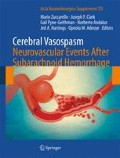Abstract
Injury depolarizations akin to spreading depression of Leão are important in the progression of tissue damage in ischemic stroke, intracranial hemorrhage, and trauma. Much of the research on injury depolarizations has been focused on their origins, electrophysiological mechanisms, and metabolic impact. Recent studies showed that injury depolarizations cause vasoconstriction and diminish perfusion, which radically differs from the predominantly hyperemic response to spreading depression in otherwise-normal brain tissue. This adverse hemodynamic effect exacerbates metabolic supply-demand mismatch and worsens the tissue outcome. Although the mechanisms transforming the hemodynamic response from vasodilation into vasoconstriction are unclear, recent data suggest a role for elevated extracellular K+ and reduced intravascular perfusion pressure, among other factors. Clues from physiological and pharmacological studies in normal or injured brain in different species suggest that the intense pandepolarization evokes multiple opposing vasomotor mechanisms with variable magnitudes and timing, providing a conceptual framework to dissect the complex neurovascular coupling in brain injury.
Access this chapter
Tax calculation will be finalised at checkout
Purchases are for personal use only
References
Bosche B, Graf R, Ernestus RI, Dohmen C, Reithmeier T, Brinker G, Strong AJ, Dreier JP, Woitzik J (2010) Recurrent spreading depolarizations after subarachnoid hemorrhage decreases oxygen availability in human cerebral cortex. Ann Neurol 67:607–617
Dreier JP, Korner K, Ebert N, Gorner A, Rubin I, Back T, Lindauer U, Wolf T, Villringer A, Einhaupl KM, Lauritzen M, Dirnagl U (1998) Nitric oxide scavenging by hemoglobin or nitric oxide synthase inhibition by N-nitro-L-arginine induces cortical spreading ischemia when K+ is increased in the subarachnoid space. J Cereb Blood Flow Metab 18:978–990
Dreier JP, Korner K, Gorner A, Lindauer U, Weih M, Villringer A, Dirnagl U (1995) Nitric oxide modulates the CBF response to increased extracellular potassium. J Cereb Blood Flow Metab 15:914–919
Dreier JP, Major S, Manning A, Woitzik J, Drenckhahn C, Steinbrink J, Tolias C, Oliveira-Ferreira AI, Fabricius M, Hartings JA, Vajkoczy P, Lauritzen M, Dirnagl U, Bohner G, Strong AJ (2009) Cortical spreading ischaemia is a novel process involved in ischaemic damage in patients with aneurysmal subarachnoid haemorrhage. Brain 132:1866–1881
Dreier JP, Petzold G, Tille K, Lindauer U, Arnold G, Heinemann U, Einhaupl KM, Dirnagl U (2001) Ischaemia triggered by spreading neuronal activation is inhibited by vasodilators in rats. J Physiol 531:515–526
Duckrow RB (1993) A brief hypoperfusion precedes spreading depression if nitric oxide synthesis is inhibited. Brain Res 618:190–195
Fabricius M, Akgoren N, Lauritzen M (1995) Arginine-nitric oxide pathway and cerebrovascular regulation in cortical spreading depression. Am J Physiol 269:H23–H29
Lauritzen M, Dreier JP, Fabricius M, Hartings JA, Graf R, Strong AJ (2010) Clinical relevance of cortical spreading depression in neurological disorders: migraine, malignant stroke, subarachnoid and intracranial hemorrhage, and traumatic brain injury. J Cereb Blood Flow Metab 31:17–35
Leao AAP (1944) Spreading depression of activity in cerebral cortex. J Neurophysiol 7:359–390
Luckl J, Zhou C, Durduran T, Yodh AG, Greenberg JH (2009) Characterization of periinfarct flow transients with laser speckle and Doppler after middle cerebral artery occlusion in the rat. J Neurosci Res 87:1219–1229
Nakamura H, Strong AJ, Dohmen C, Sakowitz OW, Vollmar S, Sue M, Kracht L, Hashemi P, Bhatia R, Yoshimine T, Dreier JP, Dunn AK, Graf R (2010) Spreading depolarizations cycle around and enlarge focal ischaemic brain lesions. Brain 133:1994–2006
Piilgaard H, Witgen BM, Rasmussen P, Lauritzen M (2011) Cyclosporine A, FK506, and NIM811 ameliorate prolonged CBF reduction and impaired neurovascular coupling after cortical spreading depression. J Cereb Blood Flow Metab 31:1588–1598
Shin HK, Dunn AK, Jones PB, Boas DA, Moskowitz MA, Ayata C (2006) Vasoconstrictive neurovascular coupling during focal ischemic depolarizations. J Cereb Blood Flow Metab 26:1018–1030
Shin HK, Nishimura M, Jones PB, Ay H, Boas DA, Moskowitz MA, Ayata C (2008) Mild induced hypertension improves blood flow and oxygen metabolism in transient focal cerebral ischemia. Stroke 39:1548–1555
Strong AJ, Anderson PJ, Watts HR, Virley DJ, Lloyd A, Irving EA, Nagafuji T, Ninomiya M, Nakamura H, Dunn AK, Graf R (2007) Peri-infarct depolarizations lead to loss of perfusion in ischaemic gyrencephalic cerebral cortex. Brain 130:995–1008
Sukhotinsky I, Dilekoz E, Moskowitz MA, Ayata C (2008) Hypoxia and hypotension transform the blood flow response to cortical spreading depression from hyperemia into hypoperfusion in the rat. J Cereb Blood Flow Metab 28:1369–1376
Sukhotinsky I, Yaseen MA, Sakadzic S, Ruvinskaya S, Sims JR, Boas DA, Moskowitz MA, Ayata C (2010) Perfusion pressure-dependent recovery of cortical spreading depression is independent of tissue oxygenation over a wide physiologic range. J Cereb Blood Flow Metab 30:1168–1177
Acknowledgment
This work was supported by NIH (NS061505, NS055104).
Conflicts of Interest
I declare that I have no conflict of interest.
Author information
Authors and Affiliations
Corresponding author
Editor information
Editors and Affiliations
Rights and permissions
Copyright information
© 2013 Springer-Verlag Wien
About this chapter
Cite this chapter
Hoffmann, U., Ayata, C. (2013). Neurovascular Coupling During Spreading Depolarizations. In: Zuccarello, M., Clark, J., Pyne-Geithman, G., Andaluz, N., Hartings, J., Adeoye, O. (eds) Cerebral Vasospasm: Neurovascular Events After Subarachnoid Hemorrhage. Acta Neurochirurgica Supplement, vol 115. Springer, Vienna. https://doi.org/10.1007/978-3-7091-1192-5_31
Download citation
DOI: https://doi.org/10.1007/978-3-7091-1192-5_31
Published:
Publisher Name: Springer, Vienna
Print ISBN: 978-3-7091-1191-8
Online ISBN: 978-3-7091-1192-5
eBook Packages: MedicineMedicine (R0)

